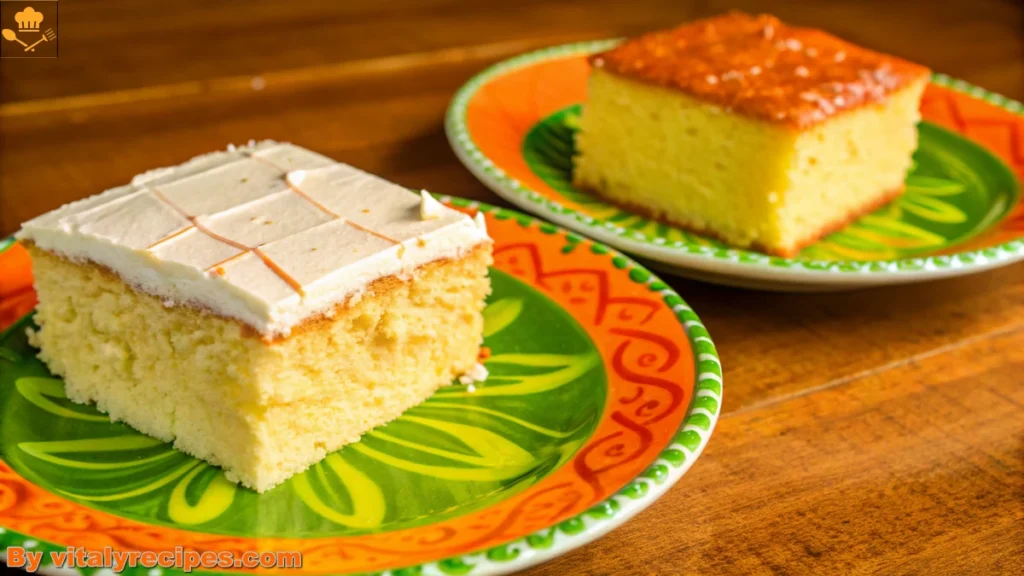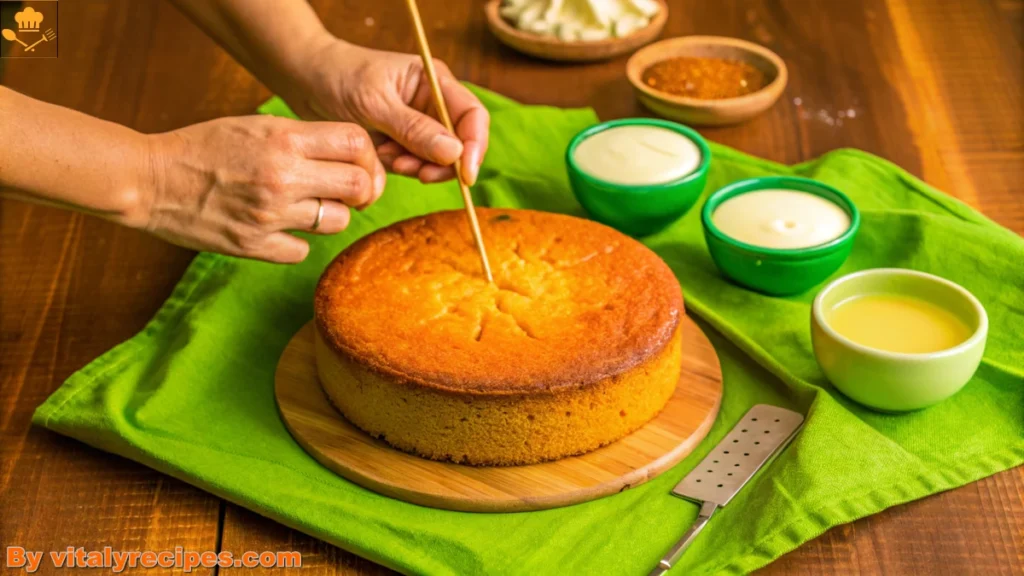Making a delicious tres leches milk not soaking should be a straightforward process, but sometimes, things don’t go as planned.
One of the most common issues people run into is when their tres leches cake just won’t soak up the milk mixture properly.
If you’ve found yourself asking, “Why are my tres leches not soaking?”, you’re not alone.
This article will walk you through some common reasons why your cake might not be absorbing the milk,
as well as tips and tricks to make sure it does.
From the texture of the cake to the preparation of the milk mixture,
every step plays a role in how well your cake soaks up that rich, creamy milk goodness. So, if your tres leches is coming out dry or too soggy, keep reading to learn how to fix it!
Common Reasons tres leches milk not soaking

If your tres leches cake isn’t soaking properly, the first thing you should consider is the cake itself. There are a few common mistakes that can prevent the cake from absorbing the milk mixture effectively. Let’s look at some of the most frequent culprits.
The Cake is Too Dense
One of the main reasons tres leches milk not soaking properly is that the cake is too dense. A dense cake has less air, which means there’s less room for the milk to absorb. This can happen if you overmix the batter or use the wrong type of flour.
When you overmix the batter, you end up creating a firmer texture that resists soaking up liquids. Ideally, the cake should be light and airy, which allows the milk to seep into every layer. If your cake feels heavy or hard when you slice into it, that might be the reason why it’s not soaking in the milk.
Insufficient Poking or Cutting the Cake
Another issue could be that you didn’t poke enough holes in the cake. Poking holes helps create pathways for the milk mixture to seep in. If the cake doesn’t have enough holes, the milk won’t be able to reach the center of the cake. You might find that the edges are soggy, but the middle remains dry.
To fix this, use a fork or skewer to poke plenty of holes all over the surface of the cake, making sure to go deep enough so the milk can penetrate thoroughly.
If you’re using a cake with a hard crust, slicing it lightly can also help ensure the milk mixture soaks properly.
In the next section, we’ll dive deeper into the importance of the cake structure itself. Understanding the role of texture can make all the difference in achieving that perfect tres leches soak.
Craving a burst of sweet summer flavor? Don’t miss out on the perfect indulgence! Dive into our blog post on Strawberry Tres Leches Cake this light, moist dessert is soaked in a luscious strawberry-infused milk mixture and topped with fluffy whipped cream. Whether you go traditional or swap in creamy Greek yogurt, you’ll savor a refreshingly decadent treat that’s guaranteed to wow at your next warm-weather gathering. Hurry and read the blog now before the summer sun sets on this delightful opportunity!
Understanding the tres leches milk not soaking Structure

When it comes to tres leches, the structure of the cake itself plays a crucial role in how well it absorbs the milk.
If your cake isn’t soaking properly, the issue could be rooted in its texture. Let’s explore how the right structure can make all the difference.
tres leches milk not soaking: The Role of Air in Cake Absorption
One key factor to consider is air. A cake that’s packed with air pockets will absorb liquids much better than one that’s too dense. The more air you incorporate into the batter, the better the cake will soak up the tres leches milk.
This is because air pockets create gaps where the milk can seep in and settle, allowing for a perfect balance of wetness and fluffiness.
If your cake has a smooth, compact texture, it may not allow enough room for the milk to soak in properly.
The best way to create air pockets is to mix your batter gently,
avoid overmixing, and make sure your baking method creates a light, airy texture.
The Importance of Sponge Texture
Another aspect of cake structure is the sponge texture. Traditional tres leches cakes have a spongy texture, which is ideal for soaking up liquids. This type of cake is light and fluffy, making it more absorbent.
If you find that your cake isn’t soaking well,
it could be because it’s too heavy or has a more dense structure that resists the milk.
The right sponge texture will absorb the milk more evenly and thoroughly,
giving you that melt-in-your-mouth texture that makes tres leches so delightful.
Correctly Preparing the Milk Mixture

Now that we’ve discussed the importance of the cake itself, let’s turn our attention to the tres leches milk mixture. Sometimes, even if your cake is perfect, improper preparation of the milk mixture can cause it not to soak properly. So, why are my tres leches not soaking? The problem might be in the milk itself.
Milk-to-Cake Ratio
A key question many bakers ask is, how much milk do I need to soak the cake? The milk-to-cake ratio is vital.
If you don’t add enough milk, the cake won’t absorb the moisture it needs,
and you’ll end up with a dry dessert.
On the flip side, if you add too much milk too quickly, the cake might become soggy instead of properly soaked.
The ideal ratio is typically about 1 to 1 ½ cups of liquid per cake,
but this can vary depending on the cake’s size and texture. If you’re struggling with soaking issues, consider adjusting the amount of milk you’re using.
Types of Milk Used
Another reason your tres leches might not be soaking is because of the type of milk you’re using. Traditional tres leches calls for a combination of whole milk, evaporated milk, and sweetened condensed milk. These three types of milk create the perfect balance of creaminess and sweetness that helps the cake absorb the liquid. If you’re using just one type of milk, like whole milk or condensed milk alone,
you might not get the same soaking effect.
For the best results, use the full combination of milk types to ensure your cake gets just the right soak it needs.
Strawberry Tres Leches Cake is a light, moist dessert that’s soaked in a strawberry-infused milk mixture and topped with fluffy whipped cream. Whether you prepare it traditionally or choose a lower-fat option by using Greek yogurt, its sweet summer flavor remains both indulgent and refreshing—perfect for any warm-weather gathering.
Why Are My Tres Leches Not Soaking? – Common Mistakes
In some cases, even if you’ve followed all the right steps, your tres leches cake still might not soak as expected.
In this part, let’s identify some of the most common mistakes that could be causing your cake to fail at soaking up the milk properly.
Overbaking the Cake
One of the most frequent mistakes people make is overbaking the cake. A tres leches cake should have a moist, spongy texture.
However, if you bake it for too long, it can become dry and dense, which makes it much harder for the milk to soak in.
Overbaking results in a tough texture, which the milk just can’t penetrate as easily.
To avoid overbaking, always follow the recipe’s suggested baking time and keep an eye on the cake as it bakes. It should be golden and slightly springy to the touch when done.
tres leches milk not soaking: Not Allowing Enough Soak Time
Another mistake is rushing the soaking process. It’s important to give the milk enough time to fully absorb into the cake.
If you pour the tres leches mixture in too quickly or don’t let it sit for long enough,
the milk will not penetrate deeply enough into the cake. The liquid needs time to seep into the cake layers, which can take a bit longer than you might think.
Patience is key! Let the cake rest for at least 30 minutes after soaking to ensure the milk has fully absorbed.
Correctly Pouring the Tres Leches Milk Mixture
Now that we’ve discussed the structure and preparation,
let’s talk about the actual process of pouring the milk mixture onto the cake. Sometimes, even if everything else seems right, pouring the milk mixture incorrectly can cause your cake to not soak properly.
Pouring Too Quickly
Pouring the tres leches mixture too quickly can overwhelm the cake. It’s tempting to pour it all in at once, but doing so might cause the cake to become unevenly soaked. Instead, try pouring the mixture in stages. Pour a little bit at a time, allowing it to soak in before adding more. This gradual method ensures that each part of the cake absorbs the milk evenly and deeply.
Using the Wrong Method to Apply the Mixture
Another issue might be the method you’re using to apply the milk mixture. It’s best to pour the mixture over the cake in a slow, steady stream, making sure it’s evenly distributed. Avoid just dumping it in one spot. For better absorption, you can even poke the cake with a fork or toothpick before pouring the milk. This creates small channels in the cake, helping the liquid penetrate better.
By being careful with the pouring method and taking your time, you’ll avoid uneven soaking and get the perfect tres leches result.
Why Are My Tres Leches Not Soaking? – Ingredients Matter
Sometimes, even if you’re following all the steps carefully, tres leches may still not soak as expected. One of the biggest factors in the success of your cake is the ingredients you’re using. In this part, we’ll look at how ingredient choices can impact the soaking process.
Using the Wrong Type of Milk
When making tres leches, it’s essential to use the correct type of milk in your soaking mixture. The three main types of milk traditionally used are evaporated milk, condensed milk, and whole milk. Substituting these ingredients with something like skim milk or a plant-based milk (like almond or soy)
can alter the way the cake absorbs the liquid.
Evaporated milk is thicker and less sweet than regular milk, while condensed milk is much sweeter and thicker. These two are crucial for achieving the right texture and taste. If you’re substituting, make sure you’re adjusting the consistency and flavor appropriately, or the cake might not soak properly.
Freshness of the Ingredients
Another important factor to consider is the freshness of your ingredients.
If your baking powder or baking soda has expired, it can affect how the cake rises and how well it soaks up the milk.
Be sure to check expiration dates before starting, as fresh ingredients help achieve a light, fluffy texture that allows for better soaking.
FAQs:
How Do I Know When the Cake Has Soaked Enough?
To confirm a well-soaked tres leches cake, ensure it feels soft, moist, and spongy. Gently press its surface; it should yield slightly, then rebound. If it remains firm or dry or a toothpick emerges clean, carefully add extra milk mixture.
Can I Make Tres Leches Cake the Day Before?
You can prepare tres leches cake a day ahead. Overnight chilling greatly enhances its moistness and flavor by allowing better milk absorption. Keep it tightly covered to prevent any dryness. When ready to serve, top with whipped cream and enjoy.
Why is My Tres Leches Cake Sinking in the Middle?
Overmixing or excessive liquid can cause tres leches cake to sink. Gentle mixing preserves light texture, and precise measuring ensures the milk mixture isn’t too heavy. Even a sunken cake is still very tasty, but proper technique prevents future collapses.
Conclusion and Final Tips
Key Takeaways
When asking, “Why are my tres leches not soaking?” it’s important to remember that the cake’s texture, soaking process, and milk mixture all play significant roles. The key to a perfectly soaked tres leches cake lies in using the right cake base, ensuring the milk mixture is evenly distributed, and allowing enough time for the cake to absorb the liquid.
Quick Summary of Tips for Ensuring Perfect Tres Leches Soaking:
- Choose the Right Cake: Use a light, airy sponge cake or chiffon cake for the best absorption.
- Correct Milk Mixture: Ensure your milk mixture is well-blended and not too thick or too thin.
- Proper Soaking Time: Let the cake absorb the liquid overnight or for at least a few hours in the fridge.
- Avoid Over-soaking: Be careful not to add too much liquid, as this can make the cake soggy rather than moist.
By following these tips, you’ll be able to enjoy a delicious, moist tres leches cake every time!







1 thought on “Why Are My Tres Leches Not Soaking?”